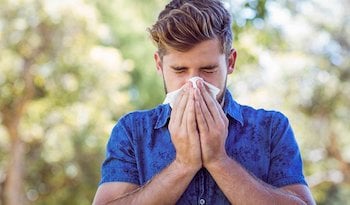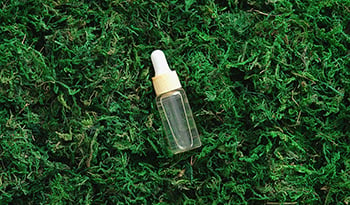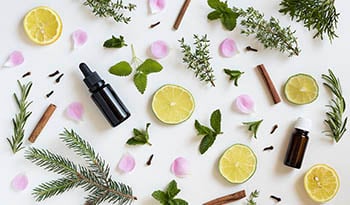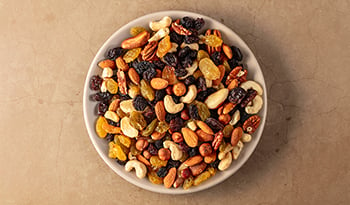10 Essential Oils for Respiratory Infections
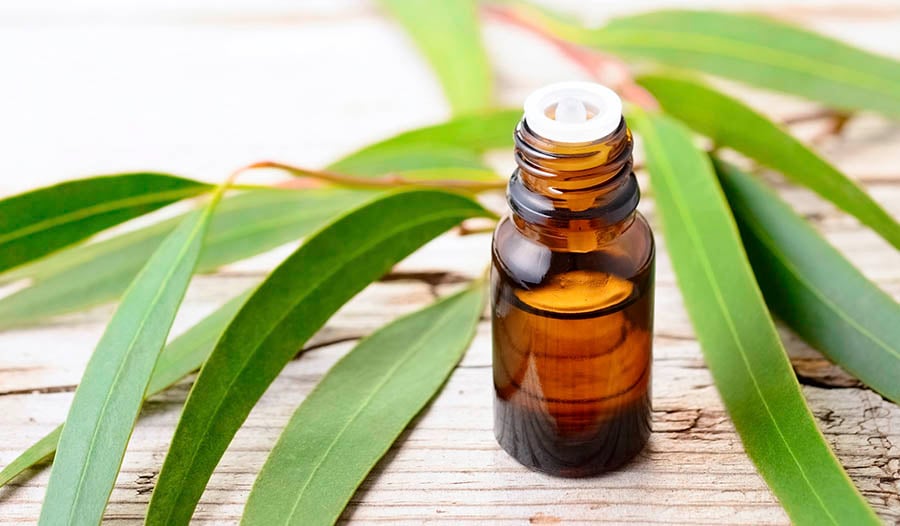
The common cold is the most frequent infection a person will ever encounter, and it is estimated that there are more than 220 different cold viruses that infect humans. After exposure, it normally takes one to three days for illness to start. The duration of a cold is usually seven days, but in some cases, it can last several weeks. The same virus never infects the same person twice, and while there is no cure for the common cold, there are ways to prevent infection, using natural treatments.
The flu (influenza) virus is a more dangerous virus, and its symptoms are more problematic than a common cold. Flu symptoms include fever, muscle aches, chills, cough, congestion, and whole-body pain. The flu can leave a person feeling dehydrated and weak, and the elderly are at higher risk for complications. Maintaining hydration and controlling symptoms is very important, as serious complications, including death, can occur as a result of the flu—sometimes, after a person is infected by a cold or flu virus, the immune system becomes weak, leaving them susceptible to a bacterial pneumonia infection. The influenza vaccine may be helpful in preventing flu infection.
In a prior article, I discussed 13 Natural Treatments for the Common Cold and Flu, which included recommended vitamins and herbs. Here, we will discuss the use of essential oils for those with an infection.
Rosemary, peppermint, and eucalyptus essential oils are recommended to help alleviate the symptoms of a cold, according to a 2011 study published in Evidence-based Complementary and Alternative Medicine, and they can also help with influenza symptoms. Wintergreen, clove, lemon, thyme, and oregano oils have also shown benefit. We will discuss this further.
How to Use Essential Oils
The wide variety of plant-based chemicals present in a given herb is the reason the herb and the equivalent essential oil have antiviral and antibacterial properties. There are many ways to use and benefit from essential oils.
Diffuser
Use of an essential oil diffuser is the best way to get the most out of these oils. I recommend diffusing the essential oil for 15 to 30 minutes up to three times during the day. Simply add a few drops of the essential oil to water and diffuse. If you are trying to improve your respiratory symptoms, consider diffusing the oil or the oil blend while you sleep.
If you do not have a diffuser, you can add a few drops of the essential oil to a spray bottle with water and spray your herbal blend around your room.
According to research, many of the essential oils listed below have antibacterial and antiviral properties and can help rid the air of airborne pathogens.
Direct Inhalation
You can inhale most essential oils directly from the bottle or apply a few drops of the essential oil to your palm and inhale gently. Some oils are stronger than others, always refer to the oil’s label for instructions as some oils may need to be diluted for topical use. Consider adding a few drops to a cup or bowl of hot water while inhaling the scented mist.
10 Essential Oils You Need in Your Medicine Cabinet
Now that you know how to use them, here are the best essential oils to help you get through cold and flu season.
Rosemary (Rosmarinus officinalis)
Rosemary is a common herb that is often grown in home gardens. It has been shown to have many health benefits and, according to an article in New York Times, rosemary plays a big part in the diet of one of the world’s healthiest and oldest living populations, those who live in Acciaroli, Italy.
Rosemary has antiviral and antibacterial properties.
Blend with eucalyptus, peppermint, frankincense and lemon.
Directions: Use with a diffuser. Place 2-3 drops in diffuser along with water. Inhale.
Eucalyptus (eucalyptus globulus, eucalyptus sideroxylon and eucalyptus torquata)
Eucalyptus is native to Australia, where Aborigines have used eucalyptus to help treat sinus infections, respiratory infections, and pain for generations. Eucalyptus is an antioxidant with potent antibacterial and antiviral properties. It also works as an expectorant, breaking up mucus in the respiratory tract.
Blend with rosemary, peppermint, frankincense, and lemon.
Directions: Use with a diffuser. Place 2-3 drops in diffuser along with water. Inhale. Avoid oral consumption of the oil.
Peppermint (Mentha piperita)
Peppermint is a well-known herb and essential oil. It is actually a hybrid of watermint and spearmint. Its smell is sharp and fresh, and one of its main components is menthol. In more recent times, it has been used as a flavoring in chewing gum. Peppermint is native to Europe and has numerous health benefits.
Blend with rosemary, eucalyptus, frankincense, and lemon.
Directions: Use with a diffuser. Place 2-3 drops in diffuser along with water. Inhale. You can also place a few drops in a glass of water to take orally.
Lemon (Citrus limonum)
Lemon is a familiar sour and sweet scent, and as an essential oil, it has many uses. It is widely used in beauty products due to its potent antioxidant properties and can be used to cleanse the skin to protect against acne. It can also be helpful for those with a chest cold and in those who have been exposed to the flu virus, according to a 2016 study in Virus Disease. Lemon oil can be ingested when diluted appropriately.
Lemon stimulates the immune system and has both antiviral and antibacterial properties.
Blend with rosemary, eucalyptus, frankincense, and peppermint.
Directions: Use with a diffuser. Place 2-3 drops in diffuser along with water. Inhale. You can also place a few drops in a glass of water to take orally. NOTE: Do not apply directly to skin, as it may cause irritation.
Chamomile
Chamomile is originally native to eastern and southern Europe. It has been used for its medicinal properties for thousands of years by the Greeks, Romans, and ancient Egyptians. It has a sweet, fruity smell. When used as an essential oil, it also has numerous health benefits, including antiseptic properties. Those with illness frequently have trouble sleeping, and Chamomile can also be consumed as an herbal tea for those wanting to get a good night’s sleep. Diffusing it will also help one to relax when ill.
Directions: Use with a diffuser. Place 2-3 drops in diffuser along with water. Inhale. You can also place a few drops in a glass of water to take orally.
Frankincense (Boswellia carteii)
Perhaps best known as a gift given by the Three Wise Men, Frankincense has historically been used in perfumes as it has a woodsy, balsamic aroma. Today, it is commonly used in religious ceremonies, including those by the Catholic Church. Frankincense is also known as boswellia to people in India and Africa, who use it for medicinal purposes—it was traded in Somalia 5,000 years ago, and at one time, this essential oil was more valuable than gold. It is mentioned in one of the oldest medical textbooks Ebers Papyrus, dated around 16th century BC.
Commonly used for respiratory infections and to stimulate the immune system. It also creates a sense of well-being.
Blend with eucalyptus, peppermint, rosemary and lemon.
Directions: Use with a diffuser. Place 2-3 drops in diffuser along with water. Inhale. You can also place a few drops in a glass of water to take orally.
Wintergreen (Gaultheria procumbens)
The Wintergreen herb was used by Indigenous cultures of North America. Infused with tea, it was consumed to help eliminate aches, pain, and sore throats from viral infections. The leaves were also chewed by Native Americans to help prevent tooth decay. Caution: wintergreen can be dangerous if you're on blood thinners as it can slow blood clotting.
Directions: Use with a diffuser. Place 2-3 drops in diffuser along with water. Inhale. Can also place a few drops in a glass of water to take orally.
Clove (Syzygium aromaticum)
Derived from a tree, clove is indigenous to Southeast Asia and Indonesia and has numerous health benefits. It is reported to have both antibacterial and antiviral properties and has been used by healers in India and China for centuries. One of clove’s main ingredients is eugenol, which has numbing and antiviral properties when applied topically. It's also said to have anti-aging properties.
Blends with lemon oil and rosemary.
Directions: Use with a diffuser. Place 2-3 drops in diffuser along with water. Inhale. You can also place a few drops in a glass of water to take orally. For a cough, apply a drop to the back of the tongue.
Thyme
Also known as red thyme, thyme is an ancient herb with medicinal properties. It was used by the Egyptians during embalming and by the Romans throughout Europe to help purify living quarters. This medicinal herb was first mentioned in the Ebers Papyrus, an ancient medical text dating from the 16th century BC.
Thyme has both antibacterial and antiviral properties. Thymol is a well-known ingredient of the herb, which has been shown to have antibacterial properties and antiviral efficiency.
Blend with rosemary.
Directions: Use with a diffuser. Place 2-3 drops in diffuser along with water. Inhale. Can also place a few drops in a glass of water to take orally.
Oregano oils (Origanum vulgare)
Oregano is a flowering plant originally from the Mediterranean region. Its name comes from the latin origanus. It has been used for centuries and has numerous health benefits, including antibacterial and antiviral properties. A 2001 study in the Journal of Applied Microbiology demonstrated its antibacterial properties.
Blends with rosemary, eucalyptus, frankincense and peppermint.
Directions: Use with a diffuser. Place 2-3 drops in diffuser along with water. Inhale. You can also place a few drops in a glass of water to take orally. Do not inhale directly as it may cause irritation to the nasal passages.
Essential Oils Can Calm Cold and Flu Symptoms Naturally
Upper respiratory infections such as the common cold and the flu can leave a person feeling miserable. Most treatment options focus on the relief of symptoms. Over the centuries, essential oils have proven to be a popular therapeutic option. The safety profile of essential oils makes them a great choice—investment in a quality air diffuser is important and will bring you and your loved ones years of relief and well-being.
References:
- Ben-Arye E, Dudai N, Eini A, Torem M, Schiff E, Rakover Y. Treatment of Upper Respiratory Tract Infections in Primary Care: A Randomized Study Using Aromatic Herbs. Evidence-based Complementary and Alternative Medicine : eCAM. 2011;2011:690346. doi:10.1155/2011/690346.
- https://www.nytimes.com/2016/10/20/world/what-in-the-world/rosemary-and-time-does-this-italian-hamlet-have-a-recipe-for-long-life.html?_r=0
- Schnitzler P., Schön K., Reichling J. Antiviral activity of Australian tea tree oil and eucalyptus oil against herpes simplex virus in cell culture. Pharmazie. 2001;56(4):343–347.
- Dhakad, A. K., Pandey, V. V., Beg, S., Rawat, J. M. and Singh, A. (2017), Biological, medicinal and toxicological significance of Eucalyptus leaf essential oil: a review. J. Sci. Food Agric. doi:10.1002/jsfa.8600
- Pourghanbari G, Nili H, Moattari A, Mohammadi A, Iraji A. Antiviral activity of the oseltamivir and Melissa officinalis L. essential oil against avian influenza A virus (H9N2). VirusDisease. 2016;27(2):170-178. doi:10.1007/s13337-016-0321-0.
- Hans VM, Grover HS, Deswal H, Agarwal P. Antimicrobial Efficacy of Various Essential Oils at Varying Concentrations against Periopathogen Porphyromonas gingivalis. Journal of Clinical and Diagnostic Research : JCDR. 2016;10(9):ZC16-ZC19. doi:10.7860/JCDR/2016/18956.8435.
- Benencia F., Courrges M. C. In vitro and in vivo activity of eugenol on human herpesvirus. Phytotherapy Research. 2000;14(7):495–500. doi: 10.1002/1099-1573(200011)14:760;495::aid-ptr65062;3.0.co;2-8.
- Roy S., Chaurvedi P., Chowdhary A. Evaluation of antiviral activity of essential oil of Trachyspermum Ammi against Japanese encephalitis virus. Pharmacognosy Research. 2015;7(3):263–267. doi: 10.4103/0974-8490.157977.
- Lambert R.J.W., Skandamis P.N., Coote P.J., Nychas G.J.E. A study of the minimum inhibitory concentration and mode of action of oregano essential oil, thymol and carvacrol. J. Appl. Microbiol. 2001;91:453–462. doi: 10.1046/j.1365-2672.2001.01428.x. [PubMed] [Cross Ref]
- Essential Oils, pocket reference by Life Science Publishing, Copyright 2016
DISCLAIMER:This Wellness Hub does not intend to provide diagnosis...














































































 Table of Contents
Table of Contents



